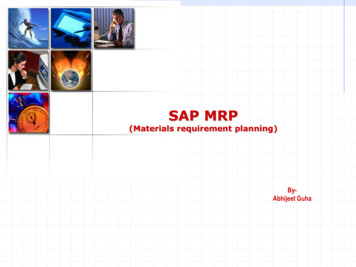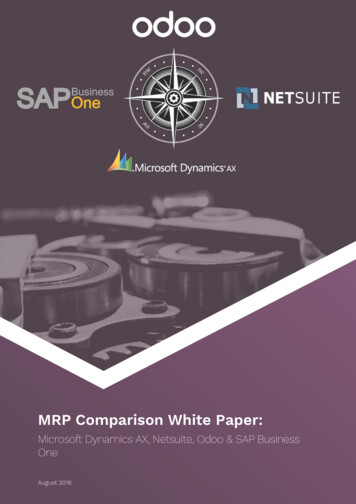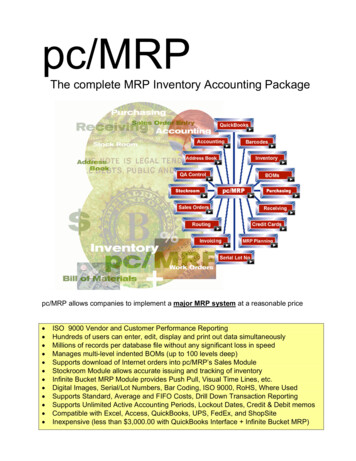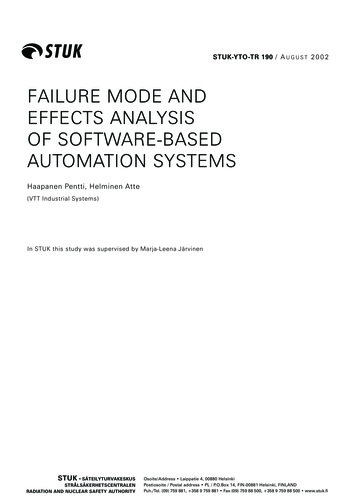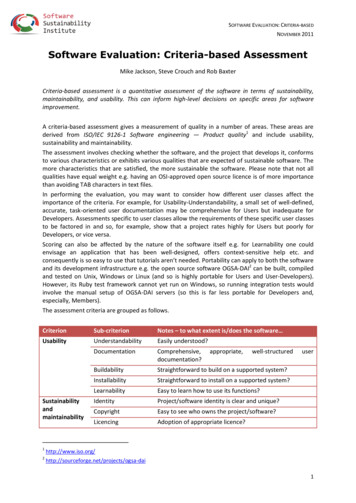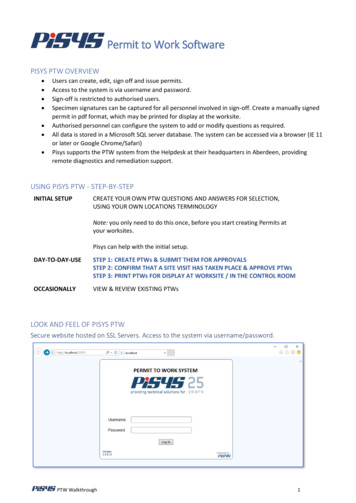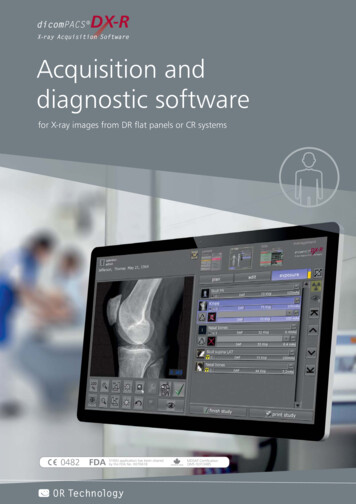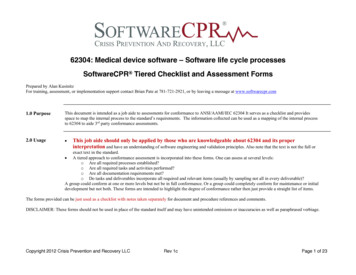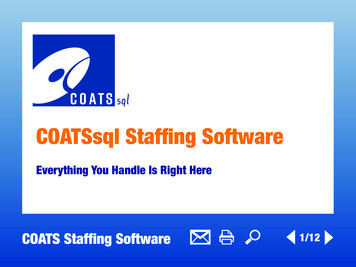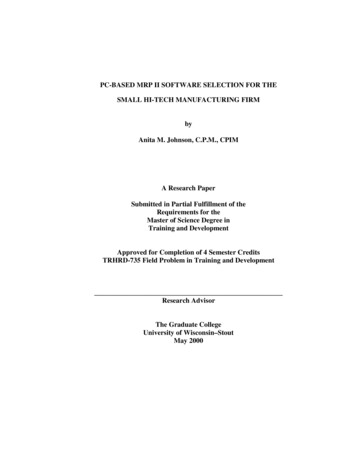
Transcription
PC-BASED MRP II SOFTWARE SELECTION FOR THESMALL HI-TECH MANUFACTURING FIRMbyAnita M. Johnson, C.P.M., CPIMA Research PaperSubmitted in Partial Fulfillment of theRequirements for theMaster of Science Degree inTraining and DevelopmentApproved for Completion of 4 Semester CreditsTRHRD-735 Field Problem in Training and DevelopmentResearch AdvisorThe Graduate CollegeUniversity of Wisconsin–StoutMay 2000
iiiABSTRACTWriterJohnson(Last Name)Anita(First Name)M.(Initial)PC-BASED MRP II SOFTWARE SELECTION FOR THE SMALL HI-TECH(Title)MANUFACTURING FIRMTraining and Development(Graduate Major)Joseph A. Benkowski(Research Advisor)May 2000(Month/Year)75(No. of Pages)APA(Name of Style Manual Used in this Study)This research details those steps that are involved with choosing the appropriateMRP II software for a small hi-tech manufacturer located in the upper midwesternportion of Wisconsin. The literature reviews and defines the objectives of materialrequirements planning. It reveals why materials requirements planning is a key elementof the strategic business plan. It states why small companies choose to hire a consultant tonarrow down the selection of software available to a manageable field of potentialsoftware selections; and why the final selection should always be done by a team of userswithin the company.The challenges associated with software selection in a small company arenumerous, including overcoming internal fear of change and how to solicit the employees“buy-in.” MRP II software is a considerable expense to any company. The transition ofcurrent policies and procedures, the implementation time, and the training are all
ivimportant elements of the cost and these elements are discussed in determining theappropriate software for a company.A search for existing surveys and ratings on PC-based MRP II software packageswas completed. These surveys and ratings were the instruments used to narrow down thepreliminary software packages to seven. Suppliers of the seven packages were contactedand received a questionnaire regarding costs, implementation times, training and followup support. The response to these questions provided the information necessary to narrowdown the field to five packages.A “needs analysis” was done by creating a process chart of the manufacturingresource planning flow to indicate which departments should have representatives on theproject team for software selection. The team members constructed a list of functions thesoftware needs to perform and created a survey of qualitative questions using the qualitytool training method called nominal group technique. The survey questions were asked ofprofessionals within other organizations using the top software packages to help identifypotential problem areas. These are negotiated in the request for quote phase of theproject. This final step of the project results in the three software packages that theresearcher will recommend.The research benefits any small manufacturing company considering the purchaseof MRP II software. It details why the selection is important, who should be involved,and what steps are necessary to do a good job. Choosing and implementing new MRP IIsoftware is a costly venture and a company needs to make the right decision. What acompany does not know could cost them a great deal of money. This paper serves as aguide to the appropriate steps in MRP II software selection.
vTABLE OF CONTENTSPageLIST OF FIGURESxACKNOWLEDGEMENTSxiChapter IINTRODUCTION1Purpose1Scope of Research1Chapter IIMRP – An Element of the Strategic Business Plan1An Overview of PC-Based MRP II Software Selection2The Various Roles Involved with Software Selection3Narrowing Down The Selection and Making a FinalChoice4Methodology5Reliability and Validity7Limitations7Protection of Human Subjects7LITERATURE REVIEW8Introduction8The Implementation of a Manufacturing Resource PlanningSystem is an Element of the Strategic Business Plan11The Objectives of MRP Defined12How MRP and MRP II Relate to Each Other12The Definition of Class A, Class B, and Class C13MRP II Users
viThe Benefits of MRP Applications13Doing a Thorough Job in Selecting your MRP IISoftware is Critical15An Overview of PC-Based MRP II Software Selection16PC-Based MRP II Software16Challenges in MRP Software Selection for the SmallCompany17Resource Allocation17Overcoming the Fear of Change and “Buy-In”18Creating an Environment of Respect withSoftware Suppliers19The Various Roles Involved with Software Selection20Management’s Role in the Selection Process20The Role of the “Users”21Narrowing Down the Selection to Three or Less Choices22Identifying Software Packages for Consideration22Steps Toward the Final SelectionRequest for Quotation2323Statement of Confidentiality23Creating an Introduction23Creating Department/Function Overviews23Stating the Reason for Change23Stating the Key Issues24Designating the Field and File Sizes24
viiChapter IIIChapter IVStating Decision Criteria and Exhibiting aMilestone Chart24Stating the Terms and Conditions24Supplier Software Demonstration24Visits to Other Manufacturers Using the SoftwarePackages25Ranking the Suppliers25Making the Final Selection26Conclusion26Definitions27RESEARCH METHODOLOGY28Research Opportunity28Research Design28Nature of Study28Sources of Data29Data Collection Procedures29Reliability and Validity30Limitations31Ethical Considerations32FINDINGS OF ANALYSIS OF RESULTS33The Needs Assessment33Computer Training Services Analysis34Questionnaire Results36Costs36
viiiAvailability Of Help And Education37Implementation and Administration of Software37Cooperation38Benchmarking Software Package CapabilitiesSummary of Demonstration ResultsChapter V3838ROI Systems39Made2Manage39Lilly Software40Syspro41Fourth Shift41Results of Survey43Recommendation of Three MRP II Software Packages45Choice #1Lilly Software Associates – Visual45Choice #2Syspro Group – Impact/Encore45Choice #3ROI Systems – Manage 200045RECOMMENDATIONS AND CONCLUSION47Costs of a Manufacturing Resource Planning softwareacquisition47Demonstration of Software48Final Words of Advice49References50Appendix ANon Applications Order Process Flow53Appendix BApplications Order Process Flow56
ixAppendix CSupplier Questionnaire59Appendix DSupplier Questionnaire Responses61Appendix ESoftware Demonstration Punchlist66Appendix FSoftware Demonstration Punchlist Responses69Appendix GCompanies Who Participated in the Qualitative CharacteristicSurvey74
xLIST OF FIGURESFigurePage2.1MRP II Model92.2ERP Model104.1CTS Rating Example354.2Top Seven Selected MRP II Software Candidates364.3Measurement Criteria and Survey Results44
xiAcknowledgementsThis paper is dedicated to my late husband Len Stewart for his encouragementand support. I also respectfully acknowledge and am very grateful to Dr. JosephBenkowski for being my advisor and program director.
Chapter IIntroductionThis research paper is entitled, “PC Based MRP II Software Selection for theSmall Hi-Tech Manufacturing Firm.” The paper represents an opportunity because itprovides guidelines and benefits in establishing a methodology for MRP II softwareselection, which will lower the acquisition and implementation costs for a company. Thescope of this paper is a small manufacturing firm in the upper midwestern part ofWisconsin. The company is a high technology manufacturer of electronic equipment witheighteen employees. Their annual sales are approximately 2.5 million dollars and theirmanufacturing planning processes have been created to facilitate an engineer-to-order andmixed mode environment. They do little master scheduling and materials are generallypurchased to the order. This company will remain anonymous throughout this paper andis referred to as Company XYZ.PurposeThe purpose of this study is to identify efficient, cost effective MRP II softwarefor Company XYZ, a small high technology electronics manufacturing firm inmidwestern Wisconsin. The final product will be a recommendation of three softwarepackages and a list of users for networking and benchmarking purposes.Scope of ResearchMRP – An Element of the Strategic Business PlanMaterial requirements planning is a process. MRP II (manufacturing resourceplanning) is a method for the effective planning of all resources of a manufacturingcompany. The software packages for MRP II include finances, sales, manufacturing
2planning and control, including MRP, capacity planning, shop floor control, procurement,engineering, quality management, and cost accounting. Manufacturing resource planningis a direct outgrowth and extension of closed-loop MRP. The benefits of implementingthe software and utilizing it effectively are numerous: reduced inventory investment,administrative costs, reduced scrap and improved customer relations.Implementing a new MRP II software package is very expensive and timeconsuming. Companies on average change their manufacturing software every seven toten years. Twenty-five to fifty percent of new implementations end in failure andseventy-five percent of implementations are considered poor. To implement a MRP IIsystem successfully, there must be commitment by all levels of management. Topmanagement must be involved at the conceptual level. A project team and leader must beselected and a methodology for selection devised.An Overview of PC based MRP II Software SelectionMRP II software programs when first developed needed the capacity of amainframe and minicomputers to run, essentially eliminating the small companies frombeing able to afford the software tool. Since the 1980s, trends and storage capacity for PCapplications have grown dramatically. Today, software for MRP implementations usingthe PC are full-fledged, powerful programs, which almost any small manufacturingcompany can afford. You can get MRP II software programs for the PC for as low as 695, but these will offer little support.There are many challenges in MRP II software selection for the small company.Resource allocation is one of these. Small companies have found that hiring a consultantis one solution to solving this issue. The consultant has to work closely with the project
3team identifying the critical business needs and incorporating details of the dailyoperation into the software analysis. A consultant can help you “think outside the box”and eliminate some of the shortcomings of the past.The fear of change can be stronger and more difficult to overcome in smallorganizations. It is important for the consultant to convince the users of the new softwarethat implementing the program successfully will enhance his or her job performance.Managers must budget for training. Studies have identified management support as oneof the essential factors affecting system success.It will be important to create an environment of respect with software suppliers.When suppliers look at small companies, they see a prospective sale that will rangeanywhere from 40,000 to 120,000. The market has never been greater for sales of MRPII software and suppliers choose who they want to have as their clients. If the smallcompany appears unknowledgeable and inexperienced, this might be interpreted as aheadache by the supplier, and they can choose not to work with the small company. Forthis reason alone, an experienced consultant can benefit the small company by helpingthem create methodical processes in the software selection process, that will minimize thetime spent by both the software manufacturer and the manufacturing firm.The Various Roles Involved with Software SelectionMany times software implementations have failed because of the lack ofcommitment by management and “users.” It is important that management show theirsupport and that the “users” are very involved from the conception of the project throughcompletion.
4Management must set the scope, understand the objectives and stand behind theimplementers. Management must subscribe to the scope of the project, but leave the keydecisions to the people who will be implementing and using the software package.Involving key employees in determining which features and functions areimportant is critical. When software falls short of expectations, the reason could be buyin of the new system. When key people are not asked for their opinions they can feelresentment. Functional areas, processes and a study of the current information system isnecessary. A project manager is elected. This person will be responsible for leading theproject. The project manager must be respected for their leadership abilities because theywill have to command respect from members of the users group and management.Everyone must know that implementation will take place and that support is critical to thesuccess of the project. It will be important for the users to be involved in thedemonstrations and on-site visits in the final round of selection.Narrowing Down the Selection and Making a Final ChoiceThere are hundreds of MRP II software packages on the market today. What is themost effective way to come up with a short list of candidates? Directories and guides willhelp lead you to the appropriate systems. APICS publishes analysis reports on variousMRP II software packages in their monthly magazine and on their website:www.apics.org.Participating in benchmarking sessions with other small manufacturers can alsobe a great way to find out what others are using and how they maximize the effectivenessof their software. Finally, hiring a consultant to help guide the process may be your best
5choice if human resources in the company are limited. If you choose a consultant, theyshould only guide you to the finalists.The final selection of the software package is the responsibility of the projectteam. The first phase would be generating a RFQ. This document should be no longerthan ten pages. The supplier will typically spend four to eight hours answering thedocumentation, so keep it precise and save time for all involved. The next phase will be ademonstration of the software for the selection team. Plan on at least at least four hoursfor this exercise.Before negotiating the price of the software the project team should conduct apersonal visit to other manufacturers using the software packages. If the need analysisand evaluation processes are followed, chances are good that the best software packagewill be acquired for the company.MethodologyA review of the literature on the topic of MRP II software selection helps informthe reader why a process is necessary in software selection and reveals the logical steps totake. It also conveys who should be involved in the process, how to prepare and what toexpect along the way. The literature review consisted of periodicals, books, and specialeditions of publications specifically related to the selection of MRP II software selectionand expert opinions from consulting firms.A questionnaire was prepared and sent to prospective suppliers asking them keypoints about their company’s philosophies and guidelines. The questions were numberedand all software candidates received the same questionnaire. The questionnaire was
6proofread by experts on MRP II software and revised accordingly. Responses werereceived and the field was narrowed down to five candidates.The project team created a “punchlist” which was sent to the five softwarecandidates and a demonstration of the software was conducted at each of their facilities.This process resulted in the elimination of one of the five candidates, because they wereunwilling to reveal names of their clients for reference for a subsequent survey that wouldfollow.The project team at Company XYZ and the consultant created a list of importantqualitative criteria, which in turn resulted in a survey form. This process was completedusing a quality tool technique called nominal group technique using a variation ofmultiple voting to determine weight values for the criteria being measured. The surveyanswered sub-problems related to the opportunity through forced choice questions todesired qualifications in the area of customer service and support. Each participant wasasked to grade questions. An example was “Please grade from A to F - UserFriendliness.” The participants, who were employees of companies using the MRP IIpackages, worked in accounting, materials management and information systems and allhad a minimum of five years using MRP II software packages. When the survey wascompleted the grades received a numerical value and a weight was assigned to eachnumerical as a result of the nominal group exercise. The category of “User Friendliness”was given a weight of .30. The grade values were added and averaged and thenmultiplied by the weight resulting in a numerical value for that category. All numericalvalues were added to establish a grade point for that software package. The researcherconducted the survey and was also the consultant for Company XYZ. Formulation,
7polling and analyzing the survey took approximately 110 hours. The survey was pretested by two experts in the MRP II field. Both experts agreed that the survey was clear,ethical and free of any prejudice.Reliability and ValidityThere were approximately 15 respondents to the survey. Before the survey wasgiven it passed a pretest that constituted a high degree of content validity. All questionsasked in the survey were identical. All individuals involved in the survey had five ormore years of experience using MRP II software packages. Face validity is established bythe currency of the articles (all within the last two years).LimitationsBecause of time and money limitations all participants of the survey werereferences of the software companies being evaluated. The software manufacturers andtheir representatives are very guarded about giving out the name of their clients to protectthem from spending too much time on good will efforts that benefit the softwarecompany. Because references were used, the responses could be skewed to a positiveresponse, but the researcher feels confident that the respondents were speaking fromexperiences, honestly and without bias.Protection of Human SubjectsAll individuals and their respective companies participating in any survey orquestionnaire for the purpose of this study are protected. No names are mentioned unlessprior permission has been granted by that individual or company. The survey andquestionnaire used in this study were reviewed by experts to prevent any prejudicial orunethical material.
Chapter IILiterature ReviewIntroductionThis research paper centers on the elements in relation to the recommendation ofmaterials resource planning software for Company XYZ, a small high technologymanufacturer located in the upper midwestern part of Wisconsin with sales of 2.5million and 18 employees. Although the focus of this project is on the recommendationof MRP II software in relation to the processes and requirements of Company XYZ thefindings and recommendations in this study can easily be used by other small companieswith similar demographic characteristics.Small manufacturing firms begin seriously thinking about budgeting formanufacturing software when the costs of keeping their accounting, inventory records,production schedule, and shipping records—usually kept on various spreadsheets—become time consuming and costly to manage. It is at this point that they start the processof looking for integrated business software. At first glance, the business periodicals mayconfuse them because they focus primarily on Enterprise Resource Planning (ERP) whichis extremely costly for the small manufacturer. Large ERP software packages are pricedby the quantity of modules purchased and can cost a business anywhere from 1 million 180 million to implement (Dozbaba, 1998). Small manufacturing firms have neither theneed nor the budget to justify this type of selection. When you compare Figure 2.1 –MRP II Model (Burt & Pinkerton, 1996) to Figure 2.2,
Lilly Software 40 Syspro 41 Fourth Shift 41 Results of Survey 43 Recommendation of Three MRP II Software Packages 45 Choice #1 Lilly Software Associates – Visual 45 Choice #2 Syspro Group – Impact/Encore 45 Choice #3 ROI Systems – Manage 2000 45 Chapter V RECOMMENDATIONS AND CON
